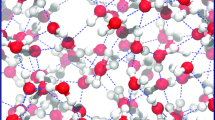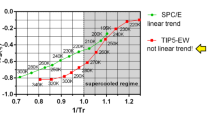Summary
On looking at the experimental findings on the thermodynamic properties of ordinary liquid water in supercooled state, we find that they can be consistently interpreted if a new contribution due to heterophase fluctuations is superimposed to a «regular» behaviour as given by a reliable extrapolation from the stable region. The «monomer» liquid which transforms into ice nuclei is associated with a «close packed» component of a two-state model interpreting the bulk medium extrapolated properties. By supposing that the amount of ice clusters depends onT M−T, whereT M is the melting temperature, we find a simple relationship between the slope of the liquid-solid equilibrium curve and the heterophase fluctuation contributions to the isothermal compressibility and thermal-expansion coefficient. The consequences are discussed and compared with sound velocity experiments in water and with the behaviour of thermodynamic properties in other supercooled liquids. A substantial agreement is found.
Riassunto
L’analisi del comportamento sperimentale delle grandezze termodinamiche nell’acqua surraffreddata ad 1 atm mostra come questo possa essere consistentemente spiegato ammettendo che un nuovo contributo, dovuto a fluttuazioni eterofasi, si sovrapponga ad un andamento «regolare» ottenuto con un’opportuna estrapolazione dalla fase stabile. La fase «monomera» che si trasforma nei nuclei di ghiaccio è associata al componente di più elevata densità di un modello a due stati che descrive la fase stabile estrapolata nella regione di metastabilità. Supponendo che la quantità di nuclei di ghiaccio dipenda daT M−T, doveT M è la temperatura di fusione, si trova una semplice relazione fra la curva di equilibrio liquido-solido ed i contributi delle fluttuazioni eterofasi alla compressibilità isoterma ed al coefficiente di dilatazione termica. Questo risultato è discusso e confrontato anche con i risultati sperimentali della velocità del suono e col comportamento delle grandezze termodinamiche in altri liquidi.
Резюме
Исследуя экспериментальные данные по термодинамическим свойствам обыкновенной жидкой воды в переохлажденном состоянии, мы находим, что эти свойства могут быть последовательно интерпретированы, если учитывается новый вклад, обусловленный гетерофазными флуктуациями, в «нормальное» поведение, получаемое при экстраполяции из устойчивой области. «Мономерная» жидкость, которая трансформируется в ледяные зародыши, связана с «плотноупакованной» компонентой модели двух состояний что позволяет интерпретировать усредненные по объему экстраполированные свойства. Предполагая, что количество ледяных кластеров зависит отT M−T, гдеT M температура плавления, мы получаем простое соотношение между наклоном кривой равновесия «жидкость-твердое тело» и вкладом гетерофазных флуктуаций в изотермическую сжимаемость и коэффициент теплового расширения. Обсуждаются следствия. Полученные результаты сравниваются с экспериментами по определению скорости звука в воде и по поведению термодинамических свойств в других переохлажденных жидкостях. Получается разумное согласие.
Similar content being viewed by others
References
R. J. Speedy andC. A. Angell:J. Chem. Phys.,65, 851 (1976).
H. E. Stanley:J. Phys. A.,12, L329 (1979).
H. E. Stanley andJ. Teixeira: paper in press onJ. Chem. Phys. (private communication).
J. Frenkel:Kinetic Theory of Liquids (New York, N. Y., 1965).
D. H. Rasmussen andA. P. MacKenzie:J. Chem. Phys.,59, 5003 (1973).
E. Trinh andA. Apfel:J. Chem. Phys.,69, 4245 (1978).
G. D’Arrigo:Nuovo Cimento B,51, 304 (1979).
A. G. Walton: inNucleation, edited byA. C. Zettlemoyer (New York, N. Y., 1969).
R. W. Hendricks, P. G. Mardon andL. B. Shaffer:J. Chem. Phys.,61, 319 (1974).
A. R. Ubbelhode:Melting and Crystal Structure (Oxford, 1965).
G. S. Kell:J. Chem. Eng. Data,20, 97 (1975).
C. T. Chen, R. A. Fine andF. J. Millero:J. Chem. Phys.,66, 2142 (1977).
D. H. Rasmussen, A. P. MacKenzie, C. A. Angell andJ. C. Tucker:Science,181, 342 (1973).
N. S. Osborne, H. F. Stimson andD. C. Ginnings:J. Res. Nat. Bur. Std.,23, 197 (1939).
G. S. Kell: inWater: A Comprehensive Treatise, Vol.1, edited byF. Franks (New York, N. Y., 1972), p. 388.
G. S. Kell:J. Chem. Eng. Data,12, 66 (1967).
E. A. Boucher: inNucleation, edited byA. C. Zettlemayer (New York, N. Y., 1969).
W. B. Hilling andC. W. McCarroll:J. Chem. Phys.,45, 3887 (1967).
G. Nemethy andH. Scheraga:J. Chem. Phys.,36, 3382 (1962).
C. M. Davis andT. A. Litovitz:J. Chem. Phys.,42, 2563 (1965).
N. E. Dorsey:Properties of Ordinary Water-Substances (New York, N. Y., 1940).
E. Eisenberg andW. Kauzmann:The Structure and Properties of Water (New York, N. Y., 1969).
W. Slie, A. Donfor andT. A. Litovitz:J. Chem. Phys.,44, 3712 (1966).
G. E. Walrafen: inWater: A Comprehensive Treatise, Vol.1, edited byF. Franks (New York, N. Y., 1972).
Such an approach was made byRasmussen andMcKenzie (5).D. H. Rasmussen andA. P. MacKenzie:J. Chem. Phys.,59, 5003 (1973). They obtained a satisfactory agreement between such estimated ad aJ evaluated from an experimental ΔC p in eq. (4.1). They, however, found an inconsistency on comparingJ with density data. This is likely due to the background forC p and ϱ they used.
W. B. Ketcham andP. V. Hobbs:Philos. Mag.,19, 1161 (1969).
V. A. Del Grosso andC. W. Mader:J. Acoust. Soc. Am.,52, 1442 (1972).
E. Trinh andA. Apfel: private communication.
J. C. Bacri andR. Rajaonarison:J. Phys. Lett. (Paris),40, L403 (1979).
E. Trinh andA. Apfel:J. Acoust. Soc. Am.,63, 777 (1978).
G. D’Arrigo:J. Chem. Phys.,63, 61 (1975).
Author information
Authors and Affiliations
Additional information
To speed up publication, the author of this paper has agreed to not receive the proofs for correction.
Перебедено редакцией
Rights and permissions
About this article
Cite this article
D’Arrigo, G. Heterophase fluctuations and thermodynamic properties in supercooled water. Nuov Cim B 61, 123–140 (1981). https://doi.org/10.1007/BF02721708
Received:
Published:
Issue Date:
DOI: https://doi.org/10.1007/BF02721708




